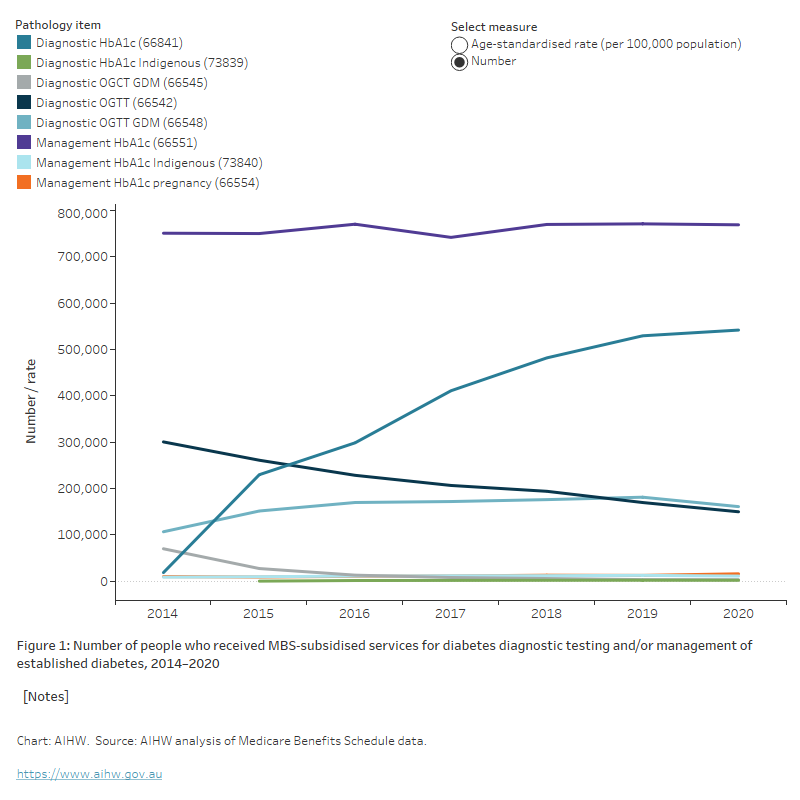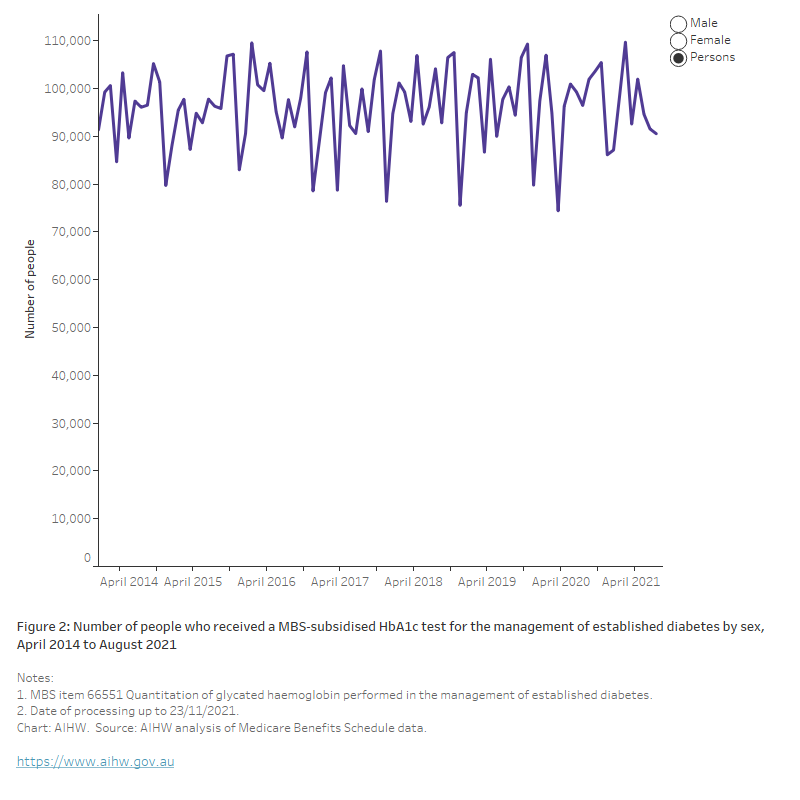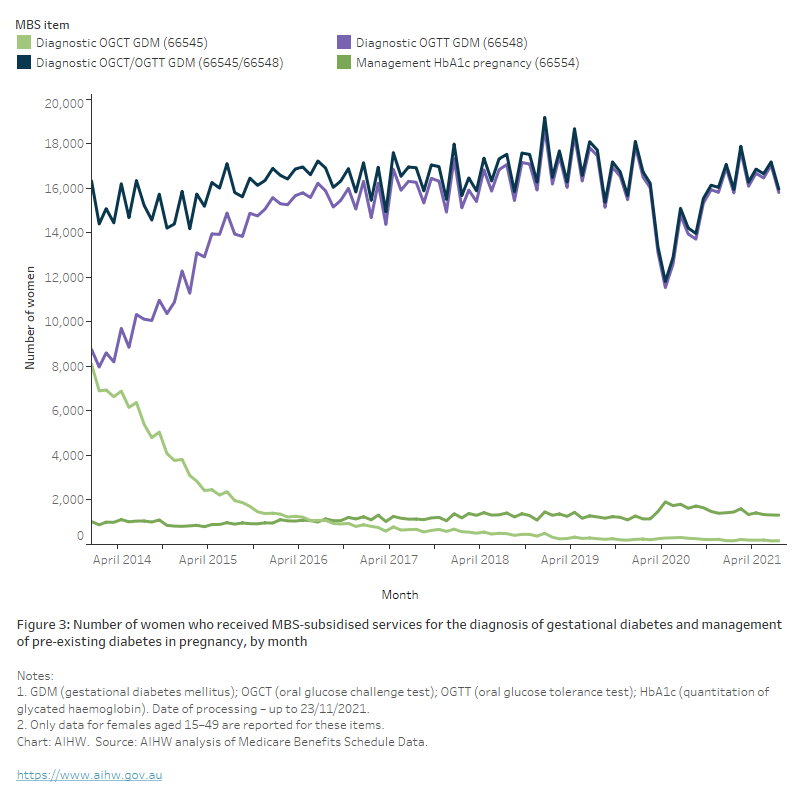Pathology
Page highlights:
- The glycated haemoglobin or haemoglobin A1C (HbA1c) test, as the standard, remains the most utilised Medicare Benefits Schedule service for diabetes diagnostic testing and the ongoing management of established diabetes.
- In 2020, 542,000 people (2,100 per 100,000 population) screened as asymptomatic though high-risk, accessed an MBS-subsidised HbA1c test to determine a diagnosis of diabetes
Monitoring established diabetes
- In 2020, 769,000 people (3,000 per 100,000 population) received a HbA1c check for the management of established diabetes.
Screening for gestational diabetes
- In 2020, 163,500 women (2,700 per 100,000 population) received a diagnostic test for gestational diabetes with most (98%) accessing the oral glucose tolerance test and a further 2% accessing the oral glucose challenge test.
- In 2019-20, 66.6% of general practice patients with a diagnosis of diabetes (20 years and older) had at least one test result for HbA1c levels – of these 52.2% had at least one result that was above the optimum goal for the management of diabetes.
Pathology service usage
The Medicare Benefits Schedule (MBS) data collection contains information on services that qualify for a benefit under the Health Insurance Act 1973 and for which a claim has been processed. These data provide insight into the usage of pathology services for diabetes diagnostic testing and the ongoing management of established diabetes, both for which the HbA1c test, as the standard, remains the most utilised MBS service (Figure 1).
Figure 1: Number of people who received MBS-subsidised services for diabetes diagnostic testing and/or management of established diabetes, 2014–2020
The chart shows the number of people who received MBS-subsidised services for the diagnosis of diabetes and/or the management of established diabetes between 2014 and 2020. The HbA1c test has remained the most utilised service for diagnosing diabetes since 2014 with around 770,000 people receiving this service in 2020. The number of people receiving the HbA1c service for the management of their diabetes has increased steadily since 2014 with around 542,000 people accessing this service in 2020.

Diagnosing diabetes
In 2020, 542,000 people (2,100 per 100,000 population) screened as asymptomatic though high-risk, received a MBS-subsidised HbA1c test to determine a diagnosis of diabetes. Overall, the number of people accessing this service generally increased with increasing age, peaking among those aged 75–79 (8,900 per 100,000 population). Rates per 100,000 population were slightly higher among females than males overall, largely driven by a spike in numbers among females in the 15–49 age group, possibly due to the use of HbA1c in pregnancy-related diabetes screening.
The introduction of the HbA1c item on the MBS for diagnostic purposes in November 2014 enabled general practitioners (GPs) to detect diabetes in people considered to be high-risk according to elevated HbA1c only rather than the more formal oral glucose tolerance test (OGTT). This shift contributed to an almost 30-fold increase in people accessing diagnostic HbA1c services through the MBS between 2014 and 2020 and a halving in the number of people accessing the MBS-subsidised OGTT (Figure 1).
Monitoring established diabetes
In 2020, 769,000 people (3,000 per 100,000 population) received a HbA1c test for the management of established diabetes. The number of people accessing this item has remained steady since 2014 and, notably through the first waves of the COVID-19 pandemic throughout 2020 and early 2021 (Figure 2). Overall numbers for the HbA1c item to monitor established diabetes were 1.4 times higher among males than females in 2020 and rates increased with increasing age, peaking among both males and females in the 75–79 age group.
While people are eligible to access MBS-subsidised HbA1c tests for the management of established diabetes up to 4 times per year, on average people received this service only 1.5 times per year between 2014 and 2020 with a similar pattern between males and females.
Figure 2: Number of people who received a MBS-subsidised HbA1c test for the management of established diabetes by sex, April 2014 to August 2021
The chart shows the number of people who received a MBS-subsidised HbA1c test for the management of established diabetes, by sex and month between January 2014 and August 2021. Overall, the number of people receiving this service remained steady over the period ranging between 74,000 and 110,000 per month.

The management of pre-existing diabetes during pregnancy is important for the wellbeing of the mother and baby. In 2020, 15,900 women (261 per 100,000 population) received a HbA1c test for the management of pre-existing diabetes in pregnancy. The number of women accessing this item has increased steadily since 2014 with a spike in April and May 2020 (Figure 3), likely impacted by temporarily revised guidelines for gestational diabetes screening in response to the COVID-19 pandemic – refer to the Impact of COVID-19: Gestational diabetes screening for further information. By early 2021, demand for this item had returned to pre-COVID levels.
Screening for gestational diabetes
Screening for gestational diabetes is universally recommended for pregnant women between 24–28 weeks’ gestation (Nankervis et al. 2014). In 2020, around 163,000 women (2,700 per 100,000 population) received a diagnostic test for gestational diabetes with most (98%) accessing the OGTT and a further 2% accessing the oral glucose challenge test (OGCT).
Gestational diabetes screening rates remained steady between 2014 and 2019, followed by an 11% drop in 2020 (down from 184,000 to 163,000 tests). Numbers in 2020 were likely impacted by temporarily revised guidelines for gestational diabetes screening in response to the COVID-19 pandemic – refer to the Impact of COVID-19: Gestational diabetes screening for further information. The number of women accessing these MBS subsidised services (processed to 1 August 2021), indicate the use of the OGTT and OGCT had returned to pre-COVID levels (Figure 3).
The use of MBS data and birth records data provide a proxy measure for the proportion of pregnant women being tested for gestational diabetes. Based on the number of women accessing the OGTT and/or OGCT, this proportion has increased steadily in recent years from 55% in 2014 to 62% in 2019. Note these figures likely underestimate the total proportion of pregnant women tested for gestational diabetes as women consistently represent around 60% of all people who receive a HbA1c test for the diagnosis of diabetes among the 15–49 age group – an indication that HbA1c may also be used for gestational diabetes screening.
Figure 3: Number of women who received MBS-subsidised services for the diagnosis of gestational diabetes and management of pre-existing diabetes in pregnancy, by month, January 2014 to August 2021
The chart shows the number of women who received MBS-subsidised services for the diagnosis of gestational diabetes and management of pre-existing diabetes in pregnancy, by month between January 2014 and August 2021. The chart reflects the impact of COVID-19 resulting in a dramatic drop in the number of women receiving the oral glucose tolerance test between April and June 2020 with a slight increase in the number of women receiving the HbA1c during this period. By October 2020, numbers had returned to pre-COVID levels.

Ongoing monitoring
Monitoring of key biomedical targets aims to reduce and manage diabetes complications. Two key monitoring targets are:
- keep blood glucose levels within a specified target range
- maintain blood pressure within acceptable levels.
Blood glucose monitoring helps health professionals determine the best management strategy for people living with diabetes. Keeping blood glucose levels within a target range can help reduce a person’s risk of developing a range of diabetes-related complications.
HbA1c testing rates
According to the NPS MedicineInsight General practice insights report (NPS MedicineWise, 2021), in 2019–20, more than two-thirds (67%) of general practice patients with a diagnosis of diabetes (20 years and older) had at least one test result for HbA1c levels. More than half of these patients (52%) had at least one result that was above the optimum goal for the management of diabetes, that being ≤ 53 mmol/mol.
Amongst MedicineInsight patients without a diagnosis of diabetes, only 11% had received at least one test for HbA1c levels. Around 3% of the general practice patients tested without diabetes had a result ≥ 48 mmol/mmol (0.3% of all patients with no recorded diagnosis of diabetes).
Median HbA1c
The Australian National Diabetes Audit – Australian Quality Clinical Audit (ANDA – AQCA) provides biennial updates on diabetes practice processes and outcome data for participating diabetes services across all states and territories in Australia (Department of Health 2021). Among all adult patients with diagnosed diabetes recording a blood glucose result (n=4,262), the median HbA1c level was 63.0 mmol/mol. Median HbA1c was slightly higher among patients with type 1 diabetes (66.0 mmol/mol) and slightly lower in patients with type 2 diabetes (62.0 mmol/mol). Patients with gestational diabetes recording a blood glucose result (n = 49) had notably lower median HbA1c levels (34.0 mmol/mol).
Diabetes with an HbA1c result
The Practice Incentives Program (PIP) Quality Improvement Measures (QI) Quality Improvement Measure 1 (QIM 1) reports on the proportion of regular clients with a recorded diagnosis of type 1, type 2 or undefined diabetes and who had a HbA1c result in their GP record from the previous 12 months. Regular clients are defined as individuals who had visited a practice 3 or more times in the previous 2 years and data are collected from over 5,700 general practices across Australia (AIHW 2021).
As of July 2021, 59% of regular clients with a record of type 1 diabetes had an HbA1c result recorded in their GP record in the previous 12 months. This proportion was higher in regular clients with a record of type 2 diabetes (73%) and undefined diabetes (66%). The proportion of regular clients with an HbA1c result in the previous 12 months increased with increasing age and was highest in the 65 and over age group for type 1, type 2 and undefined diabetes.
Diabetes with blood pressure recorded
The PIP QI Quality Improvement Measure 10 (QIM 10) provides information on the proportion of regular clients with a diagnosis of diabetes (type 1, type 2 or undefined) and a recorded blood pressure in their GP record in the previous 6 months (AIHW 2021).
As of July 2021, 59% of regular clients with diabetes had blood pressure recorded in their GP record in the previous 6 months. This proportion was 7% higher than in October 2020 (52%) and increased with increasing age. It was highest in the 65 and over age group (64% in males and 64% in females) and lowest in the 0-14 age group (6% in males and 8% in females).
Commonly used pathology checks for diabetes:
Glycated haemoglobin, haemoglobin A1c or HbA1c, is the main biomarker used to assess long-term glucose control in people living with diabetes. Haemoglobin is a protein in red blood cells which can bind with sugar to form HbA1c. It is directly related to blood glucose levels and strongly related with the development of long-term diabetes complications. Because red blood cells can live for up to 120 days, HbA1c gives an indication of blood glucose over a few months.
- The HbA1c test was endorsed for the diagnosis of diabetes in 2010 by the Australian Medical Association. Diagnosis is confirmed using HbA1c levels ≥48 mmol/L or ≥6.5%. HbA1c targets for people living with diabetes depend on the type of diabetes, life expectancy, risk of hypoglycaemia and other comorbidities. Regular monitoring for HbA1c forms an important part of diabetes management and preventing long-term complications (Wang and Hng 2021).
- The oral glucose tolerance test (OGTT) assesses venous plasma (blood) glucose before and 2 hours after a 75g oral glucose load. The OGTT is considered the gold standard for the diagnosis of gestational diabetes but may also be used in the non-pregnant population. A diagnosis of gestational diabetes is confirmed using blood glucose level – fasting (≥5.1 mmol/L); after 1 hour (≥10.0 mmol/L); after 2 hours (≥8.5 mmol/L). A diagnosis of diabetes in the non-pregnant population is confirmed using blood glucose level – fasting (≥7.0 mmol/L); after 2 hours (≥11.1 mmol/L) (RCPA 2019a).
- The oral glucose challenge test (OGCT) is a shorter version of the OGTT with (non-fasting) blood glucose measured 1 hour after a 50g or 75g oral glucose load. A level of 7.8 mmol/L for 50g (or ≥8.0 mmol/L for 75g) is the suggested cut-off for a diabetes diagnosis. Patients exceeding these cut-offs are recommended to undergo an OGTT (RCPA 2019b).
- Although not included in the analysis for this report, the Medicare Benefits Schedule (MBS) provides rebates for a range of additional services for the management of established diabetes including the quantitation of fructosamine, quantitation of urinary albumin/creatine ratio in urine, measurement of total cholesterol, triglycerides and high-density lipoprotein (HDL) cholesterol and assessment for microalbuminuria (RACGP 2020).
- From November 2021, greater emphasis has also been placed on the role of primary care in the management of established diabetes, with the introduction of routine HbA1c point-of-care services on the MBS (Department of Health 2021).
AIHW (Australian Institute of Health and Welfare) (2021) Practice Incentives Program Quality Improvement Measures: National report on the first year of data 2020-21, AIHW, Australian Government, accessed 1 December 2021.
ANDA (Australian National Diabetes Audit) (2021) Australian Quality Clinical Audit 2021 Annual Report, Department of Health, Australian Government, accessed 7 March 2022.
Department of Health (2021) Point-of-care HbA1c testing for patients with diagnosed diabetes, MBS Online website, accessed 21 March 2022.
Nankervis A, Mclntyre H, Moses R, Ross G, Callaway L, Porter C et al. (2014) ADIPS consensus guidelines for the testing and diagnosis of gestational diabetes mellitus in Australia, Sydney: Australasian Diabetes in Pregnancy Society.
NPS MedicineWise (2021) MedicineInsight General Practice Insights Report July 2019–June 2020, NPS MedicineWise, accessed 4 April 2022.
RACGP (The Royal Australian College of General Practitioners) (2020) Management of type 2 diabetes: A handbook for general practice, RACGP website, accessed 8 March 2022.
RCPA (The Royal College of Pathologists of Australasia) (2019a), Glucose Tolerance Test RCPA website, accessed 1 February 2022.
RCPA (2019b) Glucose Challenge Test, RCPA website, accessed 1 February 2022.
Wang M and Hng TM (2021) 'HbA1c: More than just a number', Australian Journal of General Practice, 50(9):628-32, doi:10.31128/AJGP-03-21-5866.


